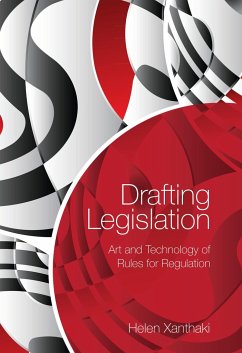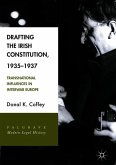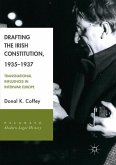- Gebundenes Buch
- Merkliste
- Auf die Merkliste
- Bewerten Bewerten
- Teilen
- Produkt teilen
- Produkterinnerung
- Produkterinnerung
This book constitutes the first thorough academic analysis of legislative drafting. It explores the reasons why drafting rules have come about and thus encourages readers to understand what is pursued by each rule and how each rule applies.
Andere Kunden interessierten sich auch für
![Rough Edges Rough Edges]() James RoganRough Edges31,99 €
James RoganRough Edges31,99 €![Freedom and the Law Freedom and the Law]() Bruno LeoniFreedom and the Law23,99 €
Bruno LeoniFreedom and the Law23,99 €![Parliamentary Reform in Britain, C. 1770-1918 Parliamentary Reform in Britain, C. 1770-1918]() Eric J EvansParliamentary Reform in Britain, C. 1770-1918181,99 €
Eric J EvansParliamentary Reform in Britain, C. 1770-1918181,99 €![Confirmation Wars Confirmation Wars]() Benjamin WittesConfirmation Wars20,99 €
Benjamin WittesConfirmation Wars20,99 €![Drafting the Irish Constitution, 1935-1937 Drafting the Irish Constitution, 1935-1937]() Donal K. CoffeyDrafting the Irish Constitution, 1935-193790,99 €
Donal K. CoffeyDrafting the Irish Constitution, 1935-193790,99 €![Drafting the Irish Constitution, 1935-1937 Drafting the Irish Constitution, 1935-1937]() Donal K. CoffeyDrafting the Irish Constitution, 1935-193790,99 €
Donal K. CoffeyDrafting the Irish Constitution, 1935-193790,99 €![Intermediated Securities Intermediated Securities]() Intermediated Securities219,99 €
Intermediated Securities219,99 €-
-
-
This book constitutes the first thorough academic analysis of legislative drafting. It explores the reasons why drafting rules have come about and thus encourages readers to understand what is pursued by each rule and how each rule applies.
Hinweis: Dieser Artikel kann nur an eine deutsche Lieferadresse ausgeliefert werden.
Hinweis: Dieser Artikel kann nur an eine deutsche Lieferadresse ausgeliefert werden.
Produktdetails
- Produktdetails
- Verlag: Bloomsbury Academic
- Seitenzahl: 400
- Erscheinungstermin: 16. Oktober 2014
- Englisch
- Abmessung: 238mm x 161mm x 28mm
- Gewicht: 744g
- ISBN-13: 9781849464284
- ISBN-10: 1849464286
- Artikelnr.: 41099397
- Herstellerkennzeichnung
- Libri GmbH
- Europaallee 1
- 36244 Bad Hersfeld
- gpsr@libri.de
- Verlag: Bloomsbury Academic
- Seitenzahl: 400
- Erscheinungstermin: 16. Oktober 2014
- Englisch
- Abmessung: 238mm x 161mm x 28mm
- Gewicht: 744g
- ISBN-13: 9781849464284
- ISBN-10: 1849464286
- Artikelnr.: 41099397
- Herstellerkennzeichnung
- Libri GmbH
- Europaallee 1
- 36244 Bad Hersfeld
- gpsr@libri.de
Helen Xanthaki
1. Legislation as a Means of Regulation: Effectiveness
in Legislative Drafting
Introduction
The Nature of Rules for Regulation: Art or Technology?
The Universality of Rules for Regulation
Compilations of Rules for Regulation: Homogeneity versus Rigidity?
Conclusions
2. Drafting Instructions
What are Drafting Instructions?
Purposes of Drafting Instructions .
The Four Principles of Drafting Instructions
What is the Content of Drafting Instructions?
Quality of Legislative Instructions
Style of Drafting Instructions
Conclusions: a Checklist for Quality Drafting Instructions
To Sum Up: Checklist for Legislative Instructions
3. The Legislative Plan: Designing a Legislative Solution
Designing a Legislative Solution: What is it?
The Advantages of Compiling a Legislative Plan
The Elements of Analysis in the Legislative Plan
Analysis of the Existing Law
Analysis of the Necessity of Legislation as a Solution
to the Identified Social Need
Analysis of Potential Danger Areas
Analysis of the Policy Options and the Preferred Legislative Solution
Analysis of the Projected Interpretation of the Legislation
Initial Considerations of Structure: Thring's Five 'Golden Rules'
Conclusions
4. Structure of a Bill
The Theory: Lord Thring's Five Rules of Drafting Revisited
More Doctrine: Bergeron's Rules
The Practice: Thornton's Approach
Structure in Brief: the Traditional Style
Structure in Brief: Innovation
Arrangements in Parts
Headings
Sections
Marginal Notes
Marginal References
Table of Arrangements or Arrangement of Sections
Real Innovation: the Layered Approach
An Example of the Layered Approach in Action:
The Succession to Crown Act 2013 (UK)
5. Clarity, Precision, Unambiguity and the Legislative Sentence
The Basics
Ambiguity and Vagueness
Semantic Ambiguity
Common Problems with Small Words: May, Shall, And/Or
Unless-Except
Scale Indicators
Terms Conveying Ranges of Numbers, Days, Dates and Ages
That and Which
Serial Commas and Ambiguity
Syntactic Ambiguity or Ambiguity at the Sentence Level
The Placement Problem
Modifiers of Nouns
Punctuation: Thornton's Four Rules of Punctuation
Gender-Neutral Drafting (gnd)
6. Plain Language
What is Plain Language?
Plain Language Aspect 1: Knowing your Audience
Plain Language Aspect 2: Easy Communication
Common Problems of Legislative Texts
Best Practices for an Easy Communication: Plain Language Innovations
The Debate: Concerns with Plain Language
Concern 1: Plain Language Lowers the Standards
of Good Writing
Concern 2: Intelligibility
Concern 3: Plain Language Can only be Achieved if Certainty is Sacrificed
Concern 4: Plain Language Leads to a Loss of Established Meanings of Words
Settled over Centuries of Judicial Interpretation
The Way Forward
7. Preliminary Provisions
The Structure of an Act
Preliminary Provisions: A Plain Language Approach
The Introductory Text (Formerly Known as Long Title)
Enacting Clause
Start Date (Formerly Known as Commencement)
Application Provisions
Innovations for the Future
8. Principal Provisions: the National, EU and International Dimension
Principal Provisions
Substantive Provisions
Administrative Agency Provisions
The EU Dimension: National Implementing Measures
The Choice of Form
The Choice of Language, Syntax and Structure
Summing up
The International Dimension: Implementing International Agreements
Innovation
9. Final Provisions
Saving Provisions
Transitional Provisions
Repeals and Consequential Amendments
Purpose Clause/Objectives
Commencement/Duration Provisions or Start/End Date
Short Title
Schedules
Schedule of Definitions
Other Schedules
10. Comparative Legislative Drafting
The Clichés
Statutory Interpretation
Rules of Interpretation and Construction in the Common Law: Ilbert's Rules
Rules of Interpretation and Construction in the Civil Law World
The End of the Cold War in (Statutory) Interpretation
Stare Decisis
Drafting Rules and Conventions
Conclusions
11. Time in Legislation
Prospective Provisions
Legalising Provisions
Retrospective Legislation
Retroactive Provisions
The Drafter and Legalising Provisions
12. Amending Provisions
Initial Considerations
Express and Implied Amendment
Direct and Indirect Amendment
Drafting Techniques for Direct Textual Amendments
Indirect Amendments
Amalgamating Indirect Referential Amendment
with Direct Textual Amendment
Consequential Amendments
Implied Repeals
13. Penal Provisions
Drafting Instructions: Initial Considerations
The Legislative Plan
The Parts of a Penal Provisions
Rules of Construction
General Rules and Innovation
Expressing the Conduct
Sanctions
Special Circumstances
Defences
Special Considerations
14. Delegated Legislation
What is Delegated Legislation?
The Role of the Drafter in Delegated Legislation
Use of Delegated Legislation
Validity of Delegated Legislation
Construction
15. Drafting for Consolidation v Drafting for Codification
Codification
Consolidation
Codification versus Consolidation
Diverse Models and the EU
16. Taxation Legislation
Understanding Drafting Instructions: Initial Considerations for the Drafter
Analysing the Proposal
Designing the Law
Initial Design
Drafting
Verification
Use of Code
17. Extra-territorial Legislation
The Theory of Extra-territoriality: Realism, Liberalism and Beyond
Extra-territoriality in Practice
Blocking Legislation
Alternatives to Blocking Legislation
The Rules on Extra-territorial Legislation
18. Statutory Interpretation and Legislative Drafting
Current Techniques of Statutory Interpretation in the UK
The Drafters' Duty
Presumptions
Maxims
Drafting and Statutory Interpretation
19. Quality of Legislation Post-Lisbon and the Role of Parliaments
The EU's Regulatory Framework for Legislative Quality
The Post-Lisbon Smart Regulation Initiative
The UK Approach to Regulatory Quality
Modern Parliaments and Legislative Quality
20. Legislative Education and Training
Education and Training
Training versus Mentoring on the Job
Clinical Education and Training in Legislative Drafting
National versus Universal Training for Drafters Conclusions
in Legislative Drafting
Introduction
The Nature of Rules for Regulation: Art or Technology?
The Universality of Rules for Regulation
Compilations of Rules for Regulation: Homogeneity versus Rigidity?
Conclusions
2. Drafting Instructions
What are Drafting Instructions?
Purposes of Drafting Instructions .
The Four Principles of Drafting Instructions
What is the Content of Drafting Instructions?
Quality of Legislative Instructions
Style of Drafting Instructions
Conclusions: a Checklist for Quality Drafting Instructions
To Sum Up: Checklist for Legislative Instructions
3. The Legislative Plan: Designing a Legislative Solution
Designing a Legislative Solution: What is it?
The Advantages of Compiling a Legislative Plan
The Elements of Analysis in the Legislative Plan
Analysis of the Existing Law
Analysis of the Necessity of Legislation as a Solution
to the Identified Social Need
Analysis of Potential Danger Areas
Analysis of the Policy Options and the Preferred Legislative Solution
Analysis of the Projected Interpretation of the Legislation
Initial Considerations of Structure: Thring's Five 'Golden Rules'
Conclusions
4. Structure of a Bill
The Theory: Lord Thring's Five Rules of Drafting Revisited
More Doctrine: Bergeron's Rules
The Practice: Thornton's Approach
Structure in Brief: the Traditional Style
Structure in Brief: Innovation
Arrangements in Parts
Headings
Sections
Marginal Notes
Marginal References
Table of Arrangements or Arrangement of Sections
Real Innovation: the Layered Approach
An Example of the Layered Approach in Action:
The Succession to Crown Act 2013 (UK)
5. Clarity, Precision, Unambiguity and the Legislative Sentence
The Basics
Ambiguity and Vagueness
Semantic Ambiguity
Common Problems with Small Words: May, Shall, And/Or
Unless-Except
Scale Indicators
Terms Conveying Ranges of Numbers, Days, Dates and Ages
That and Which
Serial Commas and Ambiguity
Syntactic Ambiguity or Ambiguity at the Sentence Level
The Placement Problem
Modifiers of Nouns
Punctuation: Thornton's Four Rules of Punctuation
Gender-Neutral Drafting (gnd)
6. Plain Language
What is Plain Language?
Plain Language Aspect 1: Knowing your Audience
Plain Language Aspect 2: Easy Communication
Common Problems of Legislative Texts
Best Practices for an Easy Communication: Plain Language Innovations
The Debate: Concerns with Plain Language
Concern 1: Plain Language Lowers the Standards
of Good Writing
Concern 2: Intelligibility
Concern 3: Plain Language Can only be Achieved if Certainty is Sacrificed
Concern 4: Plain Language Leads to a Loss of Established Meanings of Words
Settled over Centuries of Judicial Interpretation
The Way Forward
7. Preliminary Provisions
The Structure of an Act
Preliminary Provisions: A Plain Language Approach
The Introductory Text (Formerly Known as Long Title)
Enacting Clause
Start Date (Formerly Known as Commencement)
Application Provisions
Innovations for the Future
8. Principal Provisions: the National, EU and International Dimension
Principal Provisions
Substantive Provisions
Administrative Agency Provisions
The EU Dimension: National Implementing Measures
The Choice of Form
The Choice of Language, Syntax and Structure
Summing up
The International Dimension: Implementing International Agreements
Innovation
9. Final Provisions
Saving Provisions
Transitional Provisions
Repeals and Consequential Amendments
Purpose Clause/Objectives
Commencement/Duration Provisions or Start/End Date
Short Title
Schedules
Schedule of Definitions
Other Schedules
10. Comparative Legislative Drafting
The Clichés
Statutory Interpretation
Rules of Interpretation and Construction in the Common Law: Ilbert's Rules
Rules of Interpretation and Construction in the Civil Law World
The End of the Cold War in (Statutory) Interpretation
Stare Decisis
Drafting Rules and Conventions
Conclusions
11. Time in Legislation
Prospective Provisions
Legalising Provisions
Retrospective Legislation
Retroactive Provisions
The Drafter and Legalising Provisions
12. Amending Provisions
Initial Considerations
Express and Implied Amendment
Direct and Indirect Amendment
Drafting Techniques for Direct Textual Amendments
Indirect Amendments
Amalgamating Indirect Referential Amendment
with Direct Textual Amendment
Consequential Amendments
Implied Repeals
13. Penal Provisions
Drafting Instructions: Initial Considerations
The Legislative Plan
The Parts of a Penal Provisions
Rules of Construction
General Rules and Innovation
Expressing the Conduct
Sanctions
Special Circumstances
Defences
Special Considerations
14. Delegated Legislation
What is Delegated Legislation?
The Role of the Drafter in Delegated Legislation
Use of Delegated Legislation
Validity of Delegated Legislation
Construction
15. Drafting for Consolidation v Drafting for Codification
Codification
Consolidation
Codification versus Consolidation
Diverse Models and the EU
16. Taxation Legislation
Understanding Drafting Instructions: Initial Considerations for the Drafter
Analysing the Proposal
Designing the Law
Initial Design
Drafting
Verification
Use of Code
17. Extra-territorial Legislation
The Theory of Extra-territoriality: Realism, Liberalism and Beyond
Extra-territoriality in Practice
Blocking Legislation
Alternatives to Blocking Legislation
The Rules on Extra-territorial Legislation
18. Statutory Interpretation and Legislative Drafting
Current Techniques of Statutory Interpretation in the UK
The Drafters' Duty
Presumptions
Maxims
Drafting and Statutory Interpretation
19. Quality of Legislation Post-Lisbon and the Role of Parliaments
The EU's Regulatory Framework for Legislative Quality
The Post-Lisbon Smart Regulation Initiative
The UK Approach to Regulatory Quality
Modern Parliaments and Legislative Quality
20. Legislative Education and Training
Education and Training
Training versus Mentoring on the Job
Clinical Education and Training in Legislative Drafting
National versus Universal Training for Drafters Conclusions
1. Legislation as a Means of Regulation: Effectiveness
in Legislative Drafting
Introduction
The Nature of Rules for Regulation: Art or Technology?
The Universality of Rules for Regulation
Compilations of Rules for Regulation: Homogeneity versus Rigidity?
Conclusions
2. Drafting Instructions
What are Drafting Instructions?
Purposes of Drafting Instructions .
The Four Principles of Drafting Instructions
What is the Content of Drafting Instructions?
Quality of Legislative Instructions
Style of Drafting Instructions
Conclusions: a Checklist for Quality Drafting Instructions
To Sum Up: Checklist for Legislative Instructions
3. The Legislative Plan: Designing a Legislative Solution
Designing a Legislative Solution: What is it?
The Advantages of Compiling a Legislative Plan
The Elements of Analysis in the Legislative Plan
Analysis of the Existing Law
Analysis of the Necessity of Legislation as a Solution
to the Identified Social Need
Analysis of Potential Danger Areas
Analysis of the Policy Options and the Preferred Legislative Solution
Analysis of the Projected Interpretation of the Legislation
Initial Considerations of Structure: Thring's Five 'Golden Rules'
Conclusions
4. Structure of a Bill
The Theory: Lord Thring's Five Rules of Drafting Revisited
More Doctrine: Bergeron's Rules
The Practice: Thornton's Approach
Structure in Brief: the Traditional Style
Structure in Brief: Innovation
Arrangements in Parts
Headings
Sections
Marginal Notes
Marginal References
Table of Arrangements or Arrangement of Sections
Real Innovation: the Layered Approach
An Example of the Layered Approach in Action:
The Succession to Crown Act 2013 (UK)
5. Clarity, Precision, Unambiguity and the Legislative Sentence
The Basics
Ambiguity and Vagueness
Semantic Ambiguity
Common Problems with Small Words: May, Shall, And/Or
Unless-Except
Scale Indicators
Terms Conveying Ranges of Numbers, Days, Dates and Ages
That and Which
Serial Commas and Ambiguity
Syntactic Ambiguity or Ambiguity at the Sentence Level
The Placement Problem
Modifiers of Nouns
Punctuation: Thornton's Four Rules of Punctuation
Gender-Neutral Drafting (gnd)
6. Plain Language
What is Plain Language?
Plain Language Aspect 1: Knowing your Audience
Plain Language Aspect 2: Easy Communication
Common Problems of Legislative Texts
Best Practices for an Easy Communication: Plain Language Innovations
The Debate: Concerns with Plain Language
Concern 1: Plain Language Lowers the Standards
of Good Writing
Concern 2: Intelligibility
Concern 3: Plain Language Can only be Achieved if Certainty is Sacrificed
Concern 4: Plain Language Leads to a Loss of Established Meanings of Words
Settled over Centuries of Judicial Interpretation
The Way Forward
7. Preliminary Provisions
The Structure of an Act
Preliminary Provisions: A Plain Language Approach
The Introductory Text (Formerly Known as Long Title)
Enacting Clause
Start Date (Formerly Known as Commencement)
Application Provisions
Innovations for the Future
8. Principal Provisions: the National, EU and International Dimension
Principal Provisions
Substantive Provisions
Administrative Agency Provisions
The EU Dimension: National Implementing Measures
The Choice of Form
The Choice of Language, Syntax and Structure
Summing up
The International Dimension: Implementing International Agreements
Innovation
9. Final Provisions
Saving Provisions
Transitional Provisions
Repeals and Consequential Amendments
Purpose Clause/Objectives
Commencement/Duration Provisions or Start/End Date
Short Title
Schedules
Schedule of Definitions
Other Schedules
10. Comparative Legislative Drafting
The Clichés
Statutory Interpretation
Rules of Interpretation and Construction in the Common Law: Ilbert's Rules
Rules of Interpretation and Construction in the Civil Law World
The End of the Cold War in (Statutory) Interpretation
Stare Decisis
Drafting Rules and Conventions
Conclusions
11. Time in Legislation
Prospective Provisions
Legalising Provisions
Retrospective Legislation
Retroactive Provisions
The Drafter and Legalising Provisions
12. Amending Provisions
Initial Considerations
Express and Implied Amendment
Direct and Indirect Amendment
Drafting Techniques for Direct Textual Amendments
Indirect Amendments
Amalgamating Indirect Referential Amendment
with Direct Textual Amendment
Consequential Amendments
Implied Repeals
13. Penal Provisions
Drafting Instructions: Initial Considerations
The Legislative Plan
The Parts of a Penal Provisions
Rules of Construction
General Rules and Innovation
Expressing the Conduct
Sanctions
Special Circumstances
Defences
Special Considerations
14. Delegated Legislation
What is Delegated Legislation?
The Role of the Drafter in Delegated Legislation
Use of Delegated Legislation
Validity of Delegated Legislation
Construction
15. Drafting for Consolidation v Drafting for Codification
Codification
Consolidation
Codification versus Consolidation
Diverse Models and the EU
16. Taxation Legislation
Understanding Drafting Instructions: Initial Considerations for the Drafter
Analysing the Proposal
Designing the Law
Initial Design
Drafting
Verification
Use of Code
17. Extra-territorial Legislation
The Theory of Extra-territoriality: Realism, Liberalism and Beyond
Extra-territoriality in Practice
Blocking Legislation
Alternatives to Blocking Legislation
The Rules on Extra-territorial Legislation
18. Statutory Interpretation and Legislative Drafting
Current Techniques of Statutory Interpretation in the UK
The Drafters' Duty
Presumptions
Maxims
Drafting and Statutory Interpretation
19. Quality of Legislation Post-Lisbon and the Role of Parliaments
The EU's Regulatory Framework for Legislative Quality
The Post-Lisbon Smart Regulation Initiative
The UK Approach to Regulatory Quality
Modern Parliaments and Legislative Quality
20. Legislative Education and Training
Education and Training
Training versus Mentoring on the Job
Clinical Education and Training in Legislative Drafting
National versus Universal Training for Drafters Conclusions
in Legislative Drafting
Introduction
The Nature of Rules for Regulation: Art or Technology?
The Universality of Rules for Regulation
Compilations of Rules for Regulation: Homogeneity versus Rigidity?
Conclusions
2. Drafting Instructions
What are Drafting Instructions?
Purposes of Drafting Instructions .
The Four Principles of Drafting Instructions
What is the Content of Drafting Instructions?
Quality of Legislative Instructions
Style of Drafting Instructions
Conclusions: a Checklist for Quality Drafting Instructions
To Sum Up: Checklist for Legislative Instructions
3. The Legislative Plan: Designing a Legislative Solution
Designing a Legislative Solution: What is it?
The Advantages of Compiling a Legislative Plan
The Elements of Analysis in the Legislative Plan
Analysis of the Existing Law
Analysis of the Necessity of Legislation as a Solution
to the Identified Social Need
Analysis of Potential Danger Areas
Analysis of the Policy Options and the Preferred Legislative Solution
Analysis of the Projected Interpretation of the Legislation
Initial Considerations of Structure: Thring's Five 'Golden Rules'
Conclusions
4. Structure of a Bill
The Theory: Lord Thring's Five Rules of Drafting Revisited
More Doctrine: Bergeron's Rules
The Practice: Thornton's Approach
Structure in Brief: the Traditional Style
Structure in Brief: Innovation
Arrangements in Parts
Headings
Sections
Marginal Notes
Marginal References
Table of Arrangements or Arrangement of Sections
Real Innovation: the Layered Approach
An Example of the Layered Approach in Action:
The Succession to Crown Act 2013 (UK)
5. Clarity, Precision, Unambiguity and the Legislative Sentence
The Basics
Ambiguity and Vagueness
Semantic Ambiguity
Common Problems with Small Words: May, Shall, And/Or
Unless-Except
Scale Indicators
Terms Conveying Ranges of Numbers, Days, Dates and Ages
That and Which
Serial Commas and Ambiguity
Syntactic Ambiguity or Ambiguity at the Sentence Level
The Placement Problem
Modifiers of Nouns
Punctuation: Thornton's Four Rules of Punctuation
Gender-Neutral Drafting (gnd)
6. Plain Language
What is Plain Language?
Plain Language Aspect 1: Knowing your Audience
Plain Language Aspect 2: Easy Communication
Common Problems of Legislative Texts
Best Practices for an Easy Communication: Plain Language Innovations
The Debate: Concerns with Plain Language
Concern 1: Plain Language Lowers the Standards
of Good Writing
Concern 2: Intelligibility
Concern 3: Plain Language Can only be Achieved if Certainty is Sacrificed
Concern 4: Plain Language Leads to a Loss of Established Meanings of Words
Settled over Centuries of Judicial Interpretation
The Way Forward
7. Preliminary Provisions
The Structure of an Act
Preliminary Provisions: A Plain Language Approach
The Introductory Text (Formerly Known as Long Title)
Enacting Clause
Start Date (Formerly Known as Commencement)
Application Provisions
Innovations for the Future
8. Principal Provisions: the National, EU and International Dimension
Principal Provisions
Substantive Provisions
Administrative Agency Provisions
The EU Dimension: National Implementing Measures
The Choice of Form
The Choice of Language, Syntax and Structure
Summing up
The International Dimension: Implementing International Agreements
Innovation
9. Final Provisions
Saving Provisions
Transitional Provisions
Repeals and Consequential Amendments
Purpose Clause/Objectives
Commencement/Duration Provisions or Start/End Date
Short Title
Schedules
Schedule of Definitions
Other Schedules
10. Comparative Legislative Drafting
The Clichés
Statutory Interpretation
Rules of Interpretation and Construction in the Common Law: Ilbert's Rules
Rules of Interpretation and Construction in the Civil Law World
The End of the Cold War in (Statutory) Interpretation
Stare Decisis
Drafting Rules and Conventions
Conclusions
11. Time in Legislation
Prospective Provisions
Legalising Provisions
Retrospective Legislation
Retroactive Provisions
The Drafter and Legalising Provisions
12. Amending Provisions
Initial Considerations
Express and Implied Amendment
Direct and Indirect Amendment
Drafting Techniques for Direct Textual Amendments
Indirect Amendments
Amalgamating Indirect Referential Amendment
with Direct Textual Amendment
Consequential Amendments
Implied Repeals
13. Penal Provisions
Drafting Instructions: Initial Considerations
The Legislative Plan
The Parts of a Penal Provisions
Rules of Construction
General Rules and Innovation
Expressing the Conduct
Sanctions
Special Circumstances
Defences
Special Considerations
14. Delegated Legislation
What is Delegated Legislation?
The Role of the Drafter in Delegated Legislation
Use of Delegated Legislation
Validity of Delegated Legislation
Construction
15. Drafting for Consolidation v Drafting for Codification
Codification
Consolidation
Codification versus Consolidation
Diverse Models and the EU
16. Taxation Legislation
Understanding Drafting Instructions: Initial Considerations for the Drafter
Analysing the Proposal
Designing the Law
Initial Design
Drafting
Verification
Use of Code
17. Extra-territorial Legislation
The Theory of Extra-territoriality: Realism, Liberalism and Beyond
Extra-territoriality in Practice
Blocking Legislation
Alternatives to Blocking Legislation
The Rules on Extra-territorial Legislation
18. Statutory Interpretation and Legislative Drafting
Current Techniques of Statutory Interpretation in the UK
The Drafters' Duty
Presumptions
Maxims
Drafting and Statutory Interpretation
19. Quality of Legislation Post-Lisbon and the Role of Parliaments
The EU's Regulatory Framework for Legislative Quality
The Post-Lisbon Smart Regulation Initiative
The UK Approach to Regulatory Quality
Modern Parliaments and Legislative Quality
20. Legislative Education and Training
Education and Training
Training versus Mentoring on the Job
Clinical Education and Training in Legislative Drafting
National versus Universal Training for Drafters Conclusions








